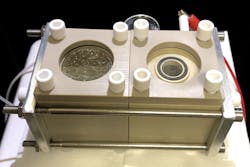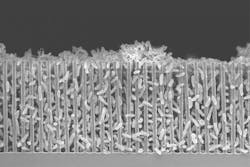Bioreactor for Mars Converts CO2 into Organic Building Blocks
If humans ever hope to colonize Mars, settlers will need to manufacture a range of organic compounds, from food to fuels to drugs, that are too expensive to ship from Earth.
Chemists at the University of California, Berkeley and Lawrence Berkeley National Laboratory have a plan for that. For the past eight years, they have been working on a hybrid device that combines bacteria and nanowires to capture sunlight’s energy to convert carbon dioxide and water into building blocks for organic molecules. Nanowires are thin silicon wires about one-hundredth the width of a human hair, used as electronic components, as well as sensors and solar cells.
Carbon dioxide is all too common in the Martian atmosphere. The only other requirement, besides sunlight, is water, which on Mars is also relatively abundant in the polar ice caps. It is also like water likely lies frozen underground over most of the planet.
The biohybrid reactor has already been shown to be able to pull carbon dioxide from the air on Earth to make organic compounds, which could lessen the effect of climate change, which many believe is caused by an excess of CO2 in the atmosphere.
The reactor achieved a record efficiency: 3.6% in converting solar energy and storing it in carbon bonds in the form of a two-carbon molecule called acetate. It is essentially acetic acid, or vinegar.
Acetate molecules can serve as building blocks for a range of organic molecules, from fuels and plastics to drugs. Many other organic products could be made from acetate inside genetically engineered organisms, such as bacteria and yeast.
The system works like photosynthesis, which plants naturally rely on to convert carbon dioxide and water to carbon compounds (mostly sugar and carbohydrates). Plants, however, have fairly low efficiencies, typically converting less than 0.5% of the solar energy they receive into carbon compounds. The new bioreactor is comparable to the plant that best converts CO2 to sugar: sugar cane, which is 4 to 5% efficient.
The team is now working on converting the bioreactor to efficiently create sugars and carbohydrates from sunlight and CO2, potentially providing food for Mars colonists.
When Yang and his colleagues first demonstrated their nanowire-bacteria hybrid reactor five years ago, the solar conversion efficiency was down at about 0.4%. The researchers tried increasing the efficiency by packing more bacteria onto the nanowires, which transfer electrons directly to the bacteria for the chemical reaction. But the bacteria separated from the nanowires, breaking the circuit.
The team eventually discovered that the bacteria, as they produced acetate, decreased the acidity (increasing the pH) of the surrounding water, which forced them to detach from the nanowires. Eventually the scientists found a way to keep the water slightly more acidic to counteract the effect of rising pH as a result of continuous acetate production. This was key in letting the team pack more bacteria onto the nanowires and upping the efficiency by nearly a factor of 10. They could also operate the reactor for a week without the bacteria peeling off.
In this particular experiment, the nanowires were used only as conductive wires, not as solar absorbers. An external solar panel provided the energy.
In a Marsbound reactor, however, nanowires would absorb light, generate electrons and transport them to bacteria on the nanowires. The bacteria take in the electrons and convert two carbon dioxide molecules and water into acetate and oxygen.
Oxygen is a side benefit and, on Mars, could replenish colonists’ artificial atmosphere, which would mimic Earth’s 21% oxygen environment.
The team has tried other improvements with good results. For example, quantum dots in bacteria’s membrane act as solar panels, absorbing sunlight and eliminating the need for silicon nanowires. These “improved” bacteria also make acetic acid. Another avenue of improvement lies in genetically engineering the bacteria so it can produce a variety of organic compounds.
“On Mars, about 96% of the atmosphere is CO2. Basically, all you need is these silicon semiconductor nanowires to take in the solar energy and pass it on to these bugs to do the chemistry for you,” says Project Leader Peidong Yang, professor of chemistry. “For a deep space mission, payload weight is critical, and biological systems have the advantage that they self-reproduce: You don’t need to send a lot. That’s why our biohybrid reactor is so attractive.”


